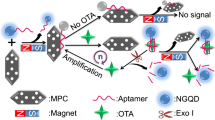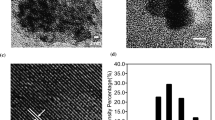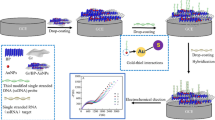Abstract
A one-pot hydrothermal method was developed for the synthesis of graphene oxide quantum dots (GOQDs). It is making use of toner waste as the precursor and H2O2 as the oxidant. Synthesis takes 4 h and does not require strong acids or complex purification steps and does not produce environmentally harmful metal ions. The GOQDs display blue fluorescence with excitation/emission maxima at 340/445 nm. The feasibility of detecting specific DNA sequence was promoted using polyethyleneimine to modify the GOQDs surface. A method was developed to recognized a specific DNA sequence. This is based on electrostatic aggregation of GOQDs and ssDNA labeled with Dabcyl at the 3′ end, which promotes fluorescence quenching of GOQDs. The possible fluorescence quenching mechanism (which is mainly dynamic) was investigated using the Stern-Volmer equation. When a target sequence was added, which is complementary to the ssDNA, the dabcyl-labeled ssDNA is released due to strict complementary base pairing. This promotes fluorescence recovery of GOQDs. The assay has a 0.17 nM detection limit and a linear range of 0.5–30 nM. The method was used to quantify specific DNA sequences from extracts of genetically modified plant tissues.

Graphene oxide quantum dots (GOQDs) were synthesized by one-pot hydrothermal method using waste toner, and the surface was modified by polyethyleneimine (PEI). Through the interaction of PEI-GOQDs with Dabcyl-DNA single strands to dynamically quench the fluorescence of GOQDs. Based on DNA hybridization technology, we established specific DNA sequence detection nanoprobe.






Similar content being viewed by others
References
Ruan J, Wang Y, Li F, Jia R, Zhou G, Shao C, Zhu L, Cui M, Yang D-P, Ge S (2018) Graphene quantum dots for radiotherapy. ACS Appl Mater Interfaces 10:14342–14355
De S, Patra K, Ghosh D, Dutta K, Dey A, Sarkar G, Maiti J, Basu A, Rana D, Chattopadhyay D (2018) Tailoring the efficacy of multifunctional biopolymeric graphene oxide quantum dot-based nanomaterial as Nanocargo in Cancer therapeutic application. ACS Biomater Sci Eng 4:514–531
Heerema SJ, Dekker C (2016) Graphene nanodevices for DNA sequencing. Nat Nanotechnol 11:127–136
Georgakilas V, Tiwari JN, Kemp KC, Perman JA, Bourlinos AB, Kim KS, Zboril R (2016) Noncovalent functionalization of graphene and graphene oxide for energy materials, biosensing, catalytic, and biomedical applications. Chem Rev 116:5464–5519
He Y, Wang H-F, Yan X-P (2009) Self-assembly of Mn-doped ZnS quantum dots/Octa(3-aminopropyl)octasilsequioxane Octahydrochloride Nanohybrids for Optosensing DNA. Chem Eur J 15:5436–5440
Liu N, Xu K, Liu L, Chen X, Zou Y, **ao XJMA (2018) A star-shaped DNA probe based on strand displacement for universal and multiplexed fluorometric detection of genetic variations. Microchim Acta 185:413
Li Y, Sun L, Qian J, Long L, Li H, Liu Q, Cai J, Wang K (2017) Fluorescent “on-off-on” switching sensor based on CdTe quantum dots coupled with multiwalled carbon nanotubes@graphene oxide nanoribbons for simultaneous monitoring of dual foreign DNAs in transgenic soybean. Biosens Bioelectron 92:26–32
Peng J, Gao W, Gupta BK, Liu Z, Romero-Aburto R, Ge L, Song L, Alemany LB, Zhan X, Gao G, Vithayathil SA, Kaipparettu BA, Marti AA, Hayashi T, Zhu J-J, Ajayan PM (2012) Graphene quantum dots derived from carbon fibers. Nano Lett 12:844–849
Ye Y-D, **a L, Xu D-D, **ng X-J, Pang D-W, Tang H-W (2016) DNA-stabilized silver nanoclusters and carbon nanoparticles oxide: a sensitive platform for label-free fluorescence turn-on detection of HIV-DNA sequences. Biosens Bioelectron 85:837–843
Liu L, Zhang C, Yu Y, Chen F (2018) Determination of DNA based on fluorescence quenching of terbium doped carbon dots. Microchim Acta 185:514–520
Ma H, Li Z, Xue N, Cheng Z, Miao XJMA (2018) A gold nanoparticle based fluorescent probe for simultaneous recognition of single-stranded DNA and double-stranded DNA. Microchim Acta 185:93–98
Qiu X, Hildebrandt N (2015) Rapid and multiplexed MicroRNA diagnostic assay using quantum dot-based Förster resonance energy transfer. ACS Nano 9:8449–8457
Qiu B, Y-s z, Y-b L, Lu Y-J, Z-y L, Wong K-Y, G-n C (2013) A novel fluorescent biosensor for detection of target DNA fragment from the transgene cauliflower mosaic virus 35S promoter. Biosens Bioelectron 41:168–171
Chen P, Wu P, Chen J, Yang P, Zhang X, Zheng C, Hou X (2016) Label-free and separation-free atomic fluorescence spectrometry-based bioassay: sensitive determination of single-Strand DNA, protein, and double-Strand DNA. Anal Chem 88:2065–2071
Shamsipur M, Barati A, Karami S (2017) Long-wavelength, multicolor, and white-light emitting carbon-based dots: achievements made, challenges remaining, and applications. Carbon 124:429–472
Allen MJ, Tung VC, Kaner RB (2010) Honeycomb carbon: a review of graphene. Chem Rev 110(1):132–145
Eigler S, Hirsch A (2014) Chemistry with graphene and graphene oxide—challenges for synthetic chemists. Angew Chem Int Ed 53:7720–7738
Yeh TF, Huang WL, Chung CJ, Chiang IT, Chen LC, Chang HY, Su WC, Cheng C, Chen S-J, Teng H (2016) Elucidating quantum confinement in graphene oxide dots based on excitation-wavelength-independent photoluminescence. J Phys Chem Lett 7:2087–2092
Li Y, Zhao Y, Cheng H, Hu Y, Shi G, Dai L, Qu L (2012) Nitrogen-doped graphene quantum dots with oxygen-rich functional groups. J Am Chem Soc 134:15–18
Achadu OJ, Revaprasadu NJMA (2019) Tannic acid-derivatized graphitic carbon nitride quantum dots as an “on-off-on” fluorescent nanoprobe for ascorbic acid via copper(II) mediation. Microchim Acta 186:87–95
Hummers WS, Offeman RE (1958) Preparation of graphitic oxide. J Am Chem Soc 80:1339–1339
Liu Y, Xu Y, Geng X, Huo Y, Chen D, Sun K, Zhou G, Chen B, Tao K (2018) Synergistic targeting and efficient photodynamic therapy based on graphene oxide quantum dot-Upconversion nanocrystal hybrid nanoparticles. Small 14:1800293
Liu F, Jang MH, Ha HD, Kim JH, Cho YH, Seo TS (2013) Facile synthetic method for pristine graphene quantum dots and graphene oxide quantum dots: origin of blue and green luminescence. Adv Mater 25:3657–3662
Kim S, Hwang SW, Kim M-K, Shin DY, Shin DH, Kim CO, Yang SB, Park JH, Hwang E, Choi S-H, Ko G, Sim S, Sone C, Choi HJ, Bae S, Hong BH (2012) Anomalous behaviors of visible luminescence from graphene quantum dots: interplay between size and shape. ACS Nano 6:8203–8208
Ye R, **ang C, Lin J, Peng Z, Huang K, Yan Z, Cook NP, Samuel ELG, Hwang C-C, Ruan G, Ceriotti G, Raji A-RO, Martí AA, Tour JM (2013) Coal as an abundant source of graphene quantum dots. Nat Commun 4:2943
Dong Y, Lin J, Chen Y, Fu F, Chi Y, Chen G (2014) Graphene quantum dots, graphene oxide, carbon quantum dots and graphite nanocrystals in coals. Nanoscale 6:7410–7415
Lu Q, Wu C, Liu D, Wang H, Su W, Li H, Zhang Y, Yao S (2017) A facile and simple method for synthesis of graphene oxide quantum dots from black carbon. Green Chem 19:900–904
Wang G, Guo Q, Chen D, Liu Z, Zheng X, Xu A, Yang S, Ding G (2018) Facile and highly effective synthesis of controllable lattice sulfur-doped graphene quantum dots via hydrothermal treatment of durian. ACS Appl Mater Interfaces 10:5750–5759
Sangam S, Gupta A, Shakeel A, Bhattacharya R, Sharma AK, Suhag D, Chakrabarti S, Garg SK, Chattopadhyay S, Basu B, Kumar V, Rajput SK, Dutta MK, Mukherjee M (2018) Sustainable synthesis of single crystalline Sulphur-doped graphene quantum dots for bioimaging and beyond. Green Chem 20:4245–4259
Dong L, Huang Z, Ruan J, Zhu J, Huang J, Huang M, Kong S, Zhang T (2017) Pyrolysis routine of organics and parameter optimization of vacuum gasification for recovering hazardous waste toner. ACS Sustain Chem Eng 5:10038–10045
Tsang MP, Kikuchi-Uehara E, Sonnemann GW, Aymonier C, Hirao M (2017) Evaluating nanotechnology opportunities and risks through integration of life-cycle and risk assessment. Nat Nanotechnol 12:734–739
Peng L, Xu Z, Liu Z, Wei Y, Sun H, Li Z, Zhao X, Gao C (2015) An iron-based green approach to 1-h production of single-layer graphene oxide. Nat Commun 6:5716
Posudievsky OY, Kozarenko OA, Khazieieva OA, Koshechko VG, Pokhodenko VD (2013) Ultrasound-free preparation of graphene oxide from mechanochemically oxidized graphite. J Mater Chem A 1:6658–6663
Qu D, Zheng M, Li J, **e Z, Sun Z (2015) Tailoring color emissions from N-doped graphene quantum dots for bioimaging applications. Light: Science &Amp; Applications 4:e364
Acknowledgments
This work was funded by the National Natural Science Foundation of China (NSFC) (Grant 31700862), the Natural Science Foundation for Young Scientists of Shanxi Province (Grant 201601D021109), and Shanxi Province Graduate Education Innovation Program (Grant 2017BY086).
Author information
Authors and Affiliations
Corresponding author
Ethics declarations
The author(s) declare that they have no competing interests.
Additional information
Publisher’s note
Springer Nature remains neutral with regard to jurisdictional claims in published maps and institutional affiliations.
Electronic supplementary material
ESM 1
(DOC 64990 kb)
Rights and permissions
About this article
Cite this article
Xu, Q., Gong, Y., Zhang, Z. et al. Preparation of graphene oxide quantum dots from waste toner, and their application to a fluorometric DNA hybridization assay. Microchim Acta 186, 483 (2019). https://doi.org/10.1007/s00604-019-3539-x
Received:
Accepted:
Published:
DOI: https://doi.org/10.1007/s00604-019-3539-x




